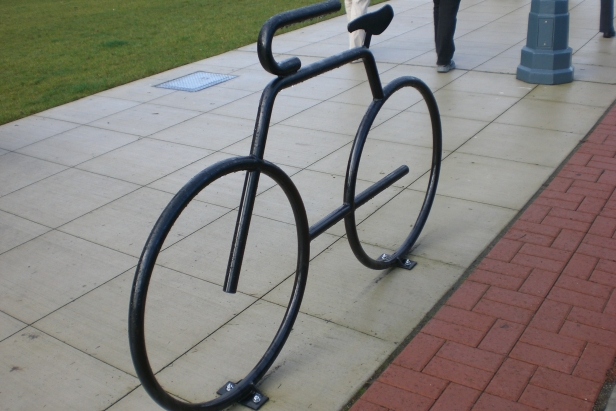Dearest readers,
 Ready to shed the chill of winter and dust off your 10-speed? (Yes, cold-weather bike warriors, I’m aware that your bike never collects dust.) We all know biking is better for the environment than jumping behind the wheel (not to mention less expensive and healthier, assuming you follow the rules of the road). So I cruised through the Ask Umbra archives in search of some inspiration to offer the bike-curious among you. Where does your bike take you? Let me know in the comments below.
Ready to shed the chill of winter and dust off your 10-speed? (Yes, cold-weather bike warriors, I’m aware that your bike never collects dust.) We all know biking is better for the environment than jumping behind the wheel (not to mention less expensive and healthier, assuming you follow the rules of the road). So I cruised through the Ask Umbra archives in search of some inspiration to offer the bike-curious among you. Where does your bike take you? Let me know in the comments below.
- Appetite for destruction.
Sounds nutty to me, but even biking can get a bad rap sometimes—including complaints about biking being a dirty industry and bikers gobbling more calories, thus increasing their carbon forkprint. Let’s start with the charge that biking is a dirty industry. Based on the Carnegie-Mellon Economic Input-Output Life Cycle Assessment model, which calculates the environmental impacts of different manufacturing sectors by dollar value, the production of bicycles is more carbon intensive than the production of cars (0.912 metric tons of carbon equivalent, OR MTCO2E, versus 0.628 MTCO2E per $1,000 of manufacturing costs). However, when we look at the total value of bikes versus cars, hands down, bikes win. Next up: that problem of a hearty cyclist’s increased caloric intake and the greenhouse gases associated with meat production, which we can neatly sidestep this one. Why would you improve your fitness and overall health by biking 20 miles a day, and then eat four steaks? Don’t eat more meat. It’s not good for your health, and it’s not good for the planet. If you must add foods due to your insatiable bike-derived hunger, let them be vegetable-based. Even on a 100 percent ground beef diet (ick), a person driving a car emits 730 kilograms of carbon equivalent per 1,000 miles, while a cyclist will emit 410 kg over the same distance. More reasonably, if the person is fueled by the typical American diet, those emissions shift to 670 and 87, respectively. Get the full Ask Umbra answer. - Highway to helmet.
Indeedy, most bike helmets are made of petroleum-based plastics, but please continue to wear your helmet and replace it after each crash. Cut the straps of your old helmet and write “crashed” on it with a permanent marker, and then throw it in the garbage. A lightweight helmet made out of plastic is a fairly innocuous object on the environmental scale. As we have learned over the years, plastic is evil due to the raw materials from which it is made and the eons that will pass ere it degrades. On the bright side, helmets are light, and hence do not require overly much fuel on their trip to the bike store or the landfill. Some companies are even tinkering with eco-friendly helmets. And you could always save your used helmets for some kind of trash sculpture. A hospital visit has the potential for much more ecological impact than your discarded helmet. Your fitness level keeps you (hopefully) from general ill health, and hence reduces the need for greenhouse-gas emitting trips to the doctor. More important, of course, the helmet protects you from serious head injury and/or death, both of which are far more environmentally costly than a piddling nine-ounce helmet. Get the full Ask Umbra answer. - Xtra-ordinary.
Even people who have much to haul and live in fickle-weather places are able to shed their cars and replace them with bikes. It just requires planning ahead and buying a bike like the Xtracycle in a design suited to your needs. It may be a tad expensive, but certainly cheaper than a car in the long term. And handy: The rear tire on the Xtracycle is farther back and lower than on a traditional bike, configured for a long, hearty rack able to hold people, four panniers, musical instruments—basically whatever you might imagine. Xtracycle offers a conversion kit for traditional bikes, too. The best news, though, is not that the Xtracycle exists and is apparently great, but that it is not the only specialty bike out there. Bikes are a form of transport, and bike hauling is its own established transport activity with appropriate technology to suit. It’s not that we must weigh down our inner Lance Armstrong with unwieldy baskets and trailers; rather, we are updating the rickshaw. If you want to haul stuff on a regular basis, there is a bike or bike-expanding attachment for you. Get the full Ask Umbra answer. - Skirting the issue.
Want to don your best skirt, dress, or utilikilt but still commute by bike? Not a problem, ladies and gents. You should be able to hunt down a small-scale bike fabricator or repair shop that could build custom skirt and chain guards. I would start by looking for a few small bike shops with that punkish, bike messengerish attitude and asking them what the options are around town. It might be that these stores actually know where to buy pre-made guards. You may already have come across my second manufacturing-related suggestion, which seems to be all over the web: Make your own skirt guard out of fabric, cable ties or wire, and a pair of scissors. Get the full Ask Umbra answer.
Banana seatly,
Umbra


